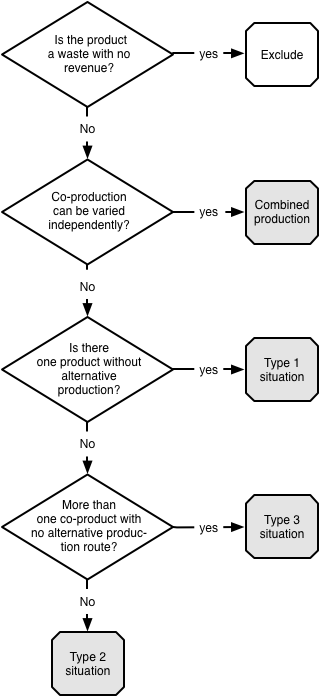Determining or dependent co‑products?
A consequential model shall – per definition – only include the activities that change as a consequence of the specific changes in demand implied by the studied decision. For a specific activity, it is therefore important to know which changes in demand determine changes in its production volume.
A determining product of an activity is defined as a product for which a change in demand will affect the production volume of the activity. It is also sometimes called a “reference product” (e.g. in ecoinvent terminology).
A product for which a change in demand does not affect the production volume of the co-producing activity is called a dependent co-product or a by-product. The production volume of a dependent co-product is constrained by the demand for the determining co-product. Since only determining products can cause a change in the production volume of an activity, dependent co-products (by-products) can never be an input to a consumption mix in a consequential system model. This also means that when the product you are interested in is a by-product, a change in demand for this product will not result in a change in the co-producing activity but will instead lead to a change in consumption for the unconstrained suppliers of the product.
It should be obvious from the above, that it is important to be able to distinguish between determining and dependent products.
Two kinds of co-production situations exist, namely combined production and joint production:
- In combined production the amounts of the co-products can be varied independently, and all products are therefore determining products, independently of each other. This modelling of physical causalities is done in the same way in attributional and consequential modelling and is therefore not the main focus of this website. However, since this procedure is not always seen as straightforward, we anyway devote a page to combined production.
- In joint production, the amounts of co-products cannot be varied independently (i.e. the proportions are fixed). When we only change the demand for one co-product and not for the others, this change cannot be fulfilled by the co-producing activity alone. It will therefore lead to changes in (substitution of) other activities as well. How the co-producing activity will react, and what other activities will be affected, depends on whether the change in demand is for a determining or for a dependent product of the joint production. Therefore, it becomes important to be able to identify unambiguously whether a specific joint product is a determining or a dependent co-product.
Below follows a step-wise procedure to identify the determining product(s) in a joint production. The procedure covers different scenarios, depending on the existence of alternative production routes for the co-products:
First, we exclude co-products for which an additional output does not provide any additional revenue (i.e. outputs that are sent to treatment or stockpiling or sold at or below the cost of preparing for sale; often labelled as “wastes”), since these can obviously not influence the production volume, and therefore cannot be determining products. For the remaining joint products we have three possible situations:
- If there is only one co-product without alternative production route, this product will be the determining product ⇒ Type 1 situation.
- If all co-products have alternative production routes, only one of these co-products can be the determining one. Data on marginal productions costs, revenues, and normalised market trends are used to identify the determining product ⇒ Type 2 situation.
- If more than one co-product has no alternative production route, all of these will be determining products ⇒ Type 3 situation.

Figure: Decision tree to identify the various situations of determining and dependent products depending on the existence of alternative production routes for the co-products.
The way the functional units of the co-products are defined and thus how their markets are delimited will also influence which scenario you will end up with.
If the products are defined very narrowly, then all products will have no alternative production route, and you will end up with a Type 3 scenario. For example, for a production of wheat grain and straw, you may define the straw as “wheat straw”, and then there will be no alternative technology for its production. Scenario 3 is not very common in practice. It is also the most difficult to model, so should you end up with a scenario 3 by error, you will anyway be motivated to take a closer look at your product definitions to see if they could not be formulated more broadly, so that more alternative production routes would become available.
If the products are defined very broadly, then all products will have alternative production routes and you will end up with a Type 2 scenario. In the wheat example, you may define the wheat grain as “grain” and straw as “biomass”, and then both products will have many alternative production routes. In extremely unfortunate situations, this may lead to the wrong product being identified as the determining. Should you have defined your product too broadly, this will typically be discovered when some specific use places a strict property requirement that can only be fulfilled by the specific product. Read more on defining the functional unit here.
These topics are also explained in this video: (go to Youtube video).
Read more
- Only one co-product without alternatives A product that has no alternative production route is typically the determining product, simply because this is only way to produce the product.
- When all co-products have alternatives If all co-products of a joint production have an alternative production route only one of these co-products can be the determining co-product.
- More than one co-product without alternative production routes When more than one co-product from a joint production have no alternative production routes, all of these co-products will be separately determining.
How to cite this: Consequential-LCA (2015). Determining or dependent co-products? Last updated: 2015-10-27. www.consequential-lca.org.